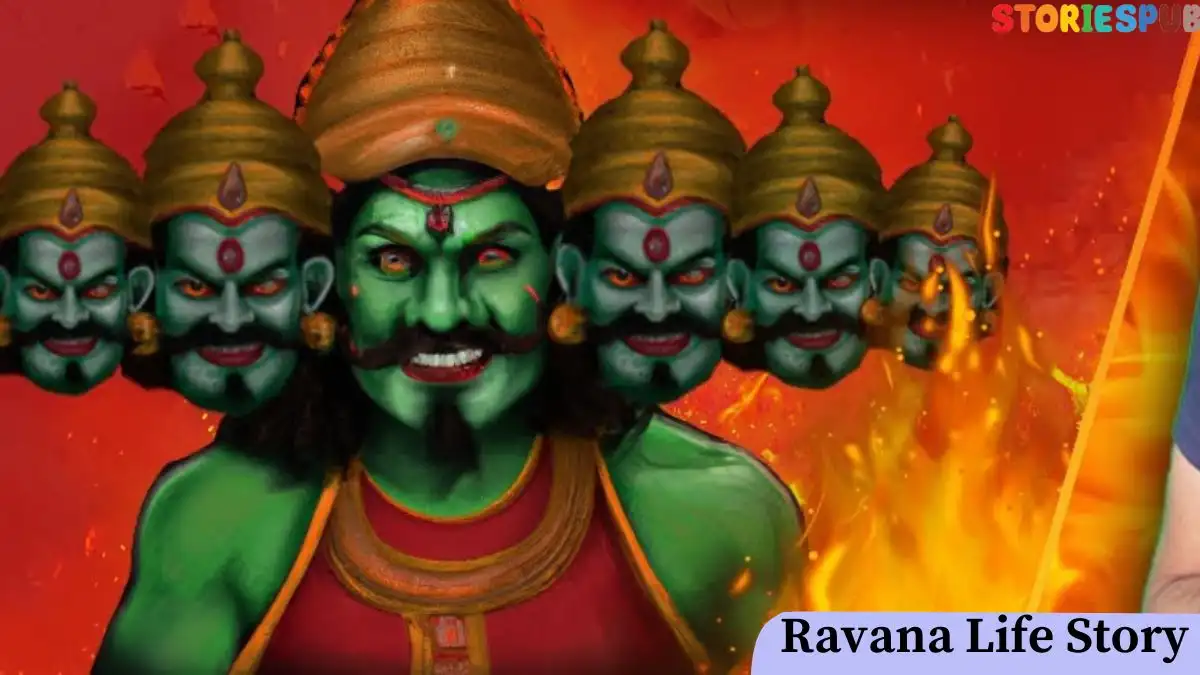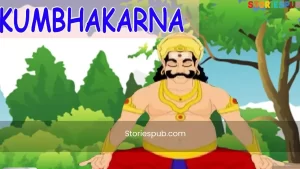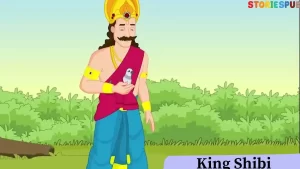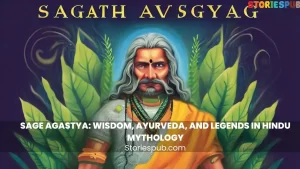Ravana Life Story: Was he a Demon, a Sage, or a Warrior

Once upon a time, in the enchanting land of Lanka, there lived a great demon king named Ravana. A complex and intriguing figure, Ravana was a master of many arts, possessing immense knowledge, prowess, and power. This is the tale of Ravana’s life, his triumphs and defeats, and his eventual demise.
Ravana was no ordinary demon. He was the son of the wise sage Vishrava and his wife Kaikesi, a Rakshasi princess. He had a brother named Kumbhakarna, a great warrior known for his enormous size and insatiable hunger, and a sister named Shurpanakha, a fierce and devious woman. Ravana had a unique lineage, being part Brahmin and part Rakshasa, which contributed to his multifaceted personality.
The demon king had many wives, but his chief queen was the beautiful and virtuous Mandodari. Together, they had several children, the most prominent of whom were Meghanada, also known as Indrajit, Atikaya, and Akshayakumara. These sons would grow up to become formidable warriors, staunchly loyal to their father and his kingdom.
Ravana was a highly accomplished individual. He was a master of the Vedas and an expert in the art of warfare. He was also an ardent devotee of Lord Shiva, from whom he received many boons that greatly enhanced his power. One such boon was the gift of invincibility against gods, demons, and celestial beings. However, this boon did not extend to humans and animals, a fact that would later play a significant role in his fate.
In addition to his vast knowledge and supernatural abilities, Ravana was also an exceptional musician, well-versed in the ancient art of playing the veena. His melodious and soothing renditions had the power to mesmerize even the gods.
Despite his many virtues, Ravana was not without flaws. His insatiable lust for power, wealth, and women ultimately led to his undoing. It was during one of his many conquests that he encountered the celestial nymph, Rambha. Bewitched by her beauty, Ravana attempted to force himself upon her.
However, Rambha was betrothed to Nalakuvara, the son of the divine treasurer, Kubera. When Nalakuvara learned of Ravana’s transgression, he cursed the demon king, stating that if he ever forced himself upon another woman, his ten heads would explode.
Undeterred by the curse, Ravana continued his quest for power and dominance. It was during this time that he came across a majestic, golden-winged deer. Captivated by its beauty, Ravana wished to possess it. The deer was, in fact, a divine being named Maricha, who was under the protection of Lord Brahma. When Ravana attempted to capture Maricha, the deer sought refuge with Lord Brahma. The lord then cursed Ravana, warning that any harm that befell Maricha would also befall him.
Ravana’s insatiable desire for power led him to seek a boon from Lord Brahma, who granted him invincibility against all celestial beings, with the exception of humans and animals. This boon would prove to be both a blessing and a curse, for it would make Ravana nearly unstoppable, yet it would also sow the seeds of his ultimate downfall.
One day, Ravana heard of the beautiful princess Sita, the wife of the exiled prince Rama. Coveting her beauty, Ravana devised a cunning plan to abduct Sita while Rama and his brother Lakshmana were away. He enlisted the help of Maricha, who had previously been cursed by Lord Brahma, to take the form of a golden deer and lure Rama and Lakshmana away from their abode. Unable to resist the allure of the deer, Rama and Lakshmana pursued it, leaving Sita unprotected.
With the brothers away, Ravana seized the opportunity to abduct Sita and whisked her away to his kingdom of Lanka. The abduction of Sita marked the beginning of Ravana’s downfall, for it set in motion a series of events that would culminate in his eventual demise.
Rama, with the help of his devoted ally, the monkey king Sugriva, and his loyal servant, the monkey general Hanuman, gathered a vast army of monkey warriors to rescue Sita and bring her back to safety. They built a bridge to Lanka with the assistance of the monkey architect Nala, and the stage was set for an epic battle between the forces of good and evil.
The battle raged on for days, with both sides displaying incredible feats of strength, courage, and skill. Ravana’s sons, Meghanada, Atikaya, and Akshayakumara, fought valiantly, but they were ultimately slain by Rama and his allies. Even Ravana’s brother, Kumbhakarna, met his end at the hands of Rama, who used his divine bow and arrows to fell the giant warrior.
Despite the loss of his family, Ravana refused to surrender, and the battle continued. Rama’s arrows, imbued with divine power, seemed to have little effect on Ravana due to the boon of invincibility he had received from Lord Brahma. However, Rama knew the secret of Ravana’s vulnerability – the nectar of immortality hidden within his navel.
In a climactic moment, Rama unleashed a powerful arrow, the Brahmastra, that pierced Ravana’s navel, neutralizing the nectar of immortality and fatally wounding the demon king. As Ravana lay dying, he acknowledged Rama’s supremacy and righteousness, expressing regret for his actions and asking for forgiveness. Rama, ever magnanimous, forgave Ravana and released his soul, allowing him to attain moksha, or liberation from the cycle of birth and death.
With Ravana defeated, Rama rescued Sita and returned to his kingdom of Ayodhya, where he was welcomed with great joy and celebration. The story of Ravana and his ultimate downfall serves as a powerful reminder of the consequences of unbridled ambition, lust, and ego. Despite his vast knowledge, immense power, and numerous accomplishments, Ravana’s flaws led him on a path of self-destruction.
In the annals of Hindu mythology, the story of Ravana stands as a testament to the complexity and depth of human nature. Ravana was a man of many contradictions – a scholar, a musician, a warrior, and a devotee of Lord Shiva. Yet, he was also a tyrant, a usurper, and a kidnapper.
His life serves as a cautionary tale, warning us against the dangers of unchecked desire and the pursuit of power at all costs. In the end, it was Ravana’s own actions that led to his demise, and his story teaches us the importance of humility, self-restraint, and the pursuit of righteousness.
The epic tale of Ravana is a rich tapestry of events and characters that has inspired countless retellings, adaptations, and interpretations throughout history. Each new version of the story brings to light different aspects of Ravana’s personality and adds further depth to his character.
In the grand narrative of Hindu mythology, Ravana’s story is a reminder of the eternal struggle between good and evil, and the ultimate triumph of righteousness over the forces of darkness. It is a tale that has been passed down through generations, inspiring and cautioning countless souls on their own journey through life.
Ravana Famous confrontations with Gods
Battle with Kubera:
The battle between Ravana and Kubera was a significant event in Ravana’s life, as it marked the beginning of his reign over the prosperous kingdom of Lanka.
Kubera, the god of wealth and the son of the sage Vishrava and his first wife, Ilavida, was the original ruler of Lanka. Ravana, who was also the son of Vishrava but with his second wife, Kaikesi, a Rakshasa princess, desired the throne of Lanka for himself. Fueled by ambition and a thirst for power, Ravana decided to challenge his half-brother for the kingdom.
The two brothers engaged in a fierce battle, showcasing their extraordinary skills in warfare and their supernatural powers. Ravana, who had received a boon of invincibility from Lord Brahma against gods, demons, and celestial beings, proved to be an extremely formidable opponent. Kubera, despite his own powers and the support of his Yaksha army, was unable to withstand Ravana’s might.
In the end, Ravana emerged victorious, defeating Kubera and forcing him to flee Lanka. Ravana then claimed the throne and established himself as the ruler of the golden city. This event not only demonstrated Ravana’s prowess in battle but also marked the beginning of his reign, which would ultimately lead to his confrontation with Rama and his eventual downfall.
Conflict with Lord Indra:
The conflict between Ravana and Lord Indra highlights Ravana’s immense power and fearlessness in challenging even the most powerful deities.
Indra, the king of the gods and the ruler of heaven, was known for his strength and prowess in battle. However, Ravana, with his insatiable lust for power, decided to challenge Indra’s authority and prove his own supremacy. The two engaged in an intense battle, with both sides displaying their extraordinary skills and divine powers.
Ravana, who had been granted the boon of invincibility against gods, demons, and celestial beings by Lord Brahma, proved to be a formidable opponent for Indra. Despite Indra’s best efforts and the use of his powerful weapon, the Vajra, he was unable to defeat Ravana. Ravana eventually overpowered Indra and took him captive, displaying his triumph over the king of the gods.
Recognizing the dire situation, Lord Brahma intervened to negotiate Indra’s release. Acknowledging Brahma’s authority and out of respect for the creator god, Ravana agreed to free Indra. This event not only showcased Ravana’s exceptional power and fearlessness but also established him as a significant threat to the gods and celestial beings.
The conflict between Ravana and Indra serves as an example of Ravana’s insatiable ambition and his willingness to challenge even the most powerful beings to assert his dominance.
Battle with Yama:
The battle between Ravana and Yama, the god of death, is yet another example of Ravana’s extraordinary might and his audacity in challenging powerful deities.
Yama, the god of death and the lord of the afterlife, is known for his stern and impartial nature, as well as his authority over the souls of the deceased. However, Ravana, with his insatiable ambition and fearlessness, decided to confront Yama, aiming to assert his dominance over the god and further establish his own supremacy.
The two engaged in a fierce battle, with Ravana and Yama displaying their extraordinary abilities and divine powers. Ravana’s boon of invincibility from Lord Brahma, which protected him against gods, demons, and celestial beings, made him an almost unstoppable force in battle. Despite Yama’s best efforts and his own formidable powers, he was unable to defeat Ravana.
In the end, Ravana emerged victorious in his confrontation with Yama, demonstrating his immense power and fearlessness. This victory over the god of death further solidified Ravana’s reputation as a formidable warrior and a force to be reckoned with.
Ravana’s battle with Yama serves as a reminder of the lengths to which he was willing to go in order to establish his dominance and showcase his power.
Confrontation with Lord Varuna:
Ravana’s confrontation with Lord Varuna, the god of the oceans and water, is another example of his unquenchable thirst for power and his readiness to challenge even the most powerful deities to assert his dominance.
Varuna, as the god of the oceans, held significant authority over the waters and their inhabitants. Ravana, however, was not content with his own power and sought to prove his supremacy by challenging Varuna. His ambition drove him to face the god of the oceans, desiring to demonstrate his control over the waters and their forces.
The two engaged in a fierce confrontation, with Ravana and Varuna showcasing their extraordinary powers and abilities.
Despite Varuna’s best efforts and his control over the forces of water, he was unable to defeat Ravana. Ravana ultimately emerged victorious in his confrontation with Varuna, demonstrating his dominance over the waters and further cementing his reputation as a powerful and fearsome warrior.
Ravana and Anaranya:
The encounter between Ravana and Anaranya, a righteous king, is a significant event in the narrative of Ravana’s life, as it foreshadows his ultimate defeat at the hands of Rama.
Anaranya was a virtuous king who, despite knowing the odds were against him, bravely faced Ravana in battle. Ravana, with his insatiable desire for conquest and power, challenged Anaranya’s rule and sought to defeat him. The two engaged in combat, with Ravana’s incredible strength and divine powers giving him the upper hand.
Although Anaranya fought valiantly, he was unable to match Ravana’s prowess, and he ultimately fell in battle. However, before dying, Anaranya cursed Ravana, prophesying that a future descendant of his lineage would avenge his death and bring about Ravana’s downfall.
Anaranya’s prophecy would eventually come true, as Rama, a descendant of Anaranya’s lineage, rose to confront Ravana and ultimately defeated him. Rama’s victory over Ravana not only fulfilled Anaranya’s curse but also marked the end of Ravana’s reign and his relentless pursuit of power.
Encounter with Ganesha:
The encounter between Ravana and Ganesha, the elephant-headed god, showcases the limits of Ravana’s power and the importance of humility and wisdom.
Ravana, in his quest for power and dominance, decided to conquer Mount Kailash, the abode of Lord Shiva, whom he deeply revered. Upon arriving at the entrance, Ravana encountered Ganesha, the son of Shiva and Parvati, who served as the gatekeeper of Mount Kailash. Undeterred by Ganesha’s presence, Ravana, in his arrogance and overconfidence, attempted to move Mount Kailash with his bare hands.
Ganesha, known for his wisdom and cleverness, realized the potential danger posed by Ravana’s actions and decided to outsmart the demon king. Using his divine powers, Ganesha caused the mountain to become extremely heavy and immovable, thwarting Ravana’s efforts to lift it.
Despite his immense strength and supernatural abilities, Ravana was unable to move Mount Kailash. He ultimately realized that he had been outwitted by Ganesha and was forced to abandon his plan to conquer Lord Shiva’s abode. This encounter with Ganesha served as a humbling lesson for Ravana, demonstrating the importance of humility and the limitations of brute strength.
The story of Ravana’s encounter with Ganesha highlights the consequences of arrogance and overconfidence, as well as the value of wisdom and resourcefulness in overcoming challenges. It is a reminder that even the most powerful beings can be humbled by wisdom and the clever use of one’s abilities.
Ravana and Nandi:
The interaction between Ravana and Nandi, the divine bull and vehicle of Lord Shiva, serves as an important episode that further foreshadows Ravana’s eventual downfall due to his arrogance.
As Ravana set out on his quest to conquer Mount Kailash, he encountered Nandi, who was entrusted with guarding the abode of Lord Shiva. Filled with arrogance and overconfidence in his own abilities, Ravana insulted Nandi, belittling him for his appearance as a bull.
This insult deeply angered Nandi, who recognized the danger that Ravana’s unchecked arrogance posed. In retaliation, Nandi cursed Ravana, prophesying that his downfall would be brought about by a monkey. This curse would prove to be a significant turning point in Ravana’s life, as it foreshadowed the role of Hanuman, the monkey god, in his eventual defeat.
As the story unfolds, Hanuman plays a crucial role in assisting Rama during the battle against Ravana, by locating Sita, setting Lanka on fire, and even helping Rama’s army cross the ocean to reach Lanka. It is through Hanuman’s contributions that Rama is ultimately able to defeat Ravana, thereby fulfilling Nandi’s curse.
Ravana and Hanuman:
The story of Ravana and Hanuman is a well-known tale from Hindu mythology. It begins with Ravana, the powerful demon king of Lanka, abducting Sita, the wife of Lord Rama, who was an avatar of Lord Vishnu.
Lord Rama, along with his brother Lakshmana and an army of monkeys led by Hanuman, set out to rescue Sita from Ravana’s clutches. Hanuman, being a loyal and brave servant of Lord Rama, was chosen to infiltrate Lanka and find Sita.
As Hanuman flew over the city of Lanka in search of Sita, he caught sight of Ravana’s palace and decided to investigate. He sneaked into the palace, and after a brief search, he found Sita imprisoned in a beautiful garden.
Hanuman then revealed himself to Sita, and she was overjoyed to see a friendly face. Hanuman assured Sita that he would soon return with Rama and Lakshmana to rescue her. Before leaving, Hanuman wanted to show Ravana the might of Lord Rama’s army and warn him of the impending war.
As he was leaving the palace, Hanuman was caught by Ravana’s guards, who took him to the king. Ravana was intrigued by Hanuman’s size and appearance, and he asked Hanuman who he was and why he had come to Lanka.
Hanuman replied that he was a messenger of Lord Rama and had come to rescue Sita. Ravana, being the arrogant and powerful demon king, scoffed at Hanuman’s claims and ordered his guards to set Hanuman’s tail on fire.
But Hanuman, being a devout devotee of Lord Rama, had the power of the divine within him. Instead of being burned, his tail blazed into a fiery inferno, and Hanuman used it to set Ravana’s palace and the city of Lanka on fire.
Ravana was shocked and terrified by Hanuman’s power and ordered his guards to put out the fire. But it was too late, and the city was in ruins.
Hanuman then made his escape from Lanka, returned to Lord Rama and told him all that he had seen and done. This encounter between Hanuman and Ravana was a prelude to the epic battle that was to come between Rama’s army and Ravana’s forces, which ultimately ended in Ravana’s defeat and the rescue of Sita.
Battle with Jatayu:
The story of Jatayu and his battle with Ravana is an important part of the Ramayana, an epic Hindu poem. Jatayu was a giant eagle and an old friend of Rama’s father, King Dasharatha. He was known for his bravery and loyalty.
When Ravana abducted Sita, Jatayu saw it happen and flew to her rescue. Jatayu fought valiantly against Ravana, trying to save Sita from his clutches. However, Ravana was a powerful demon king, and he quickly overpowered Jatayu in battle.
Despite his injuries, Jatayu refused to give up and continued to fight. He clung onto Ravana’s chariot as the demon king took Sita away to Lanka. But eventually, Ravana managed to sever Jatayu’s wings and left him lying on the ground, severely injured.
When Rama and his brother Lakshmana arrived in the forest and began searching for Sita, they came across Jatayu. The bird was barely alive and told Rama about the abduction and Ravana’s involvement. Jatayu urged Rama to rescue Sita and avenge his injuries.
Rama and Lakshmana were heartbroken at the sight of their old friend lying helpless on the ground. They performed the last rites for Jatayu and mourned his loss deeply.
Jatayu’s bravery and sacrifice were not forgotten, and his story became an inspiration for generations to come. His valiant efforts to rescue Sita from Ravana’s clutches were a testament to the power of loyalty, courage, and selflessness.
Some interesting and lesser-known facts about Ravana
- Ravana was a great devotee of Lord Shiva and composed the Shiva Tandava Stotram, a hymn praising the god. It is believed that Lord Shiva granted him the boon of invincibility in exchange for his devotion.
- Ravana was a learned scholar with vast knowledge of the Vedas, astrology, and Ayurveda. He was also an expert in the science of political governance, known as Arthashastra.
- Ravana was a skilled musician and a master of the veena, a stringed musical instrument. Legend has it that he invented the Ravanahatha, a precursor to the modern violin.
- Ravana was an adept linguist and is said to have been fluent in many languages, including Sanskrit, the divine language of the gods.
- Ravana’s ten heads are symbolic of his vast knowledge and wisdom, as each head represents a different aspect of human intelligence.
- Ravana’s city, Lanka, was made of gold and was known as the “City of Gold.” It was a prosperous and advanced city that boasted impressive architecture and advanced technology.
- Ravana’s brother, Vibhishana, defected to Rama’s side during the war against Ravana. After Ravana’s death, Vibhishana was crowned the new king of Lanka by Rama.
- Ravana was said to possess the Amrita Kalasha, a pot containing the nectar of immortality. This nectar was hidden in his navel, making him nearly immortal.
- Ravana was a devotee of the goddess Durga as well. It is believed that he performed a special puja for her, which involved making 108 lotus flowers out of his own flesh. Durga was impressed by his devotion and granted him a boon.
- Ravana was a great warrior and had the power to change his form at will. This ability allowed him to deceive and overpower his enemies, as well as to escape from difficult situations.
- Ravana’s flag was adorned with the image of a crow, symbolizing his cunning nature and his ability to outwit his opponents.
- Ravana’s aerial vehicle, the Pushpaka Vimana, was a gift from Lord Brahma. The vehicle had the ability to change its size and shape, as well as to travel at incredible speeds.
- Despite Ravana’s many negative traits, he was known for his strong sense of justice and fair governance in his kingdom. Lanka flourished under his rule, and he was respected by his subjects.
- Ravana is still worshipped in some parts of India, Sri Lanka, and Bali, where he is considered to be a symbol of wisdom, knowledge, and strength.
- Ravana is also mentioned in Jain and Buddhist texts, as well as in the Ramayana of Southeast Asian countries such as Cambodia, Thailand, and Indonesia, where the story has been adapted and localized to suit their own cultural contexts.
Hey kids, how much did you like The Ravana Life Story: Was he a Demon, a Sage, or a Warrior? Please share your view in the comment box. Also, please share this story with your friends on social media so they can also enjoy it, and for more such Hindu Mythology, , please bookmark storiespub.com.
Check out other stories that we have:





